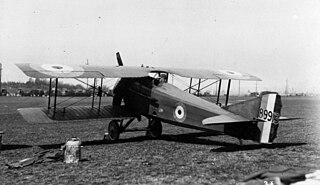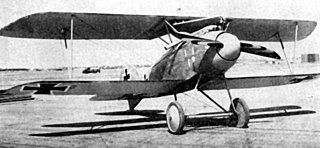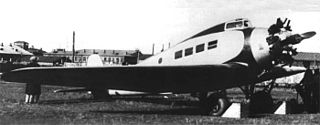
The Ilyushin Il-10 is a Soviet ground attack aircraft developed at the end of World War II by the Ilyushin construction bureau. It was also license-built in Czechoslovakia by Avia as the Avia B-33.

The Kharkiv KhAI-5, was a Soviet reconnaissance and light bomber aircraft, designed in the mid-1930s in the Kharkiv Aviation Institute, under the direction of Iosif Grigorevich Nyeman.

The SPAD S.VII C.1 was the first in a series of single-seat biplane fighter aircraft produced by Société Pour L'Aviation et ses Dérivés (SPAD) during the First World War. Like its successors, the S.VII was renowned as a sturdy and rugged aircraft with good diving characteristics. It was also a stable gun platform, although pilots used to the more maneuverable Nieuport fighters found it heavy on the controls. It was flown by a number of the famous aces, such as France's Georges Guynemer, Italy's Francesco Baracca and Australia's Alexander Pentland.

The Albatros D.III was a biplane fighter aircraft used by the Imperial German Army Air Service during World War I. A modified licensed version was built by Oeffag for the Austro-Hungarian Air Service (Luftfahrtruppen). The D.III was flown by many top German aces, including Wilhelm Frankl, Erich Löwenhardt, Manfred von Richthofen, Karl Emil Schäfer, Ernst Udet, and Kurt Wolff, and Austro-Hungarians like Godwin von Brumowski. It was the preeminent fighter during the period of German aerial dominance known as "Bloody April" 1917.

The Yakovlev Yak-2 was a short-range Soviet light bomber/reconnaissance aircraft used during World War II. It was produced in small numbers, and most of them were destroyed during the opening stages of Operation Barbarossa.

Grigorovich M-5 was a successful Russian World War I-era two-bay unequal-span biplane flying boat with a single step hull, designed by Grigorovich. It was the first mass production flying boat built in Russia.

The Albatros C.XV was a German military reconnaissance aircraft developed during World War I. It was essentially a refinement of the C.XII, which had been put into production in 1918. The war ended before any examples became operational. However, some found their way into civilian hands and flew as transport aircraft in peacetime under the factory designation L 47. Others saw service with the air forces of Russia, Turkey, and Latvia.
The Anatra V.I. was a Russian reconnaissance aircraft of World War I. It was a redesign of the French Voisin III undertaken by Podporuchik Piotr Ivanov in Zhmerynka. The Voisin's fuselage pod was replaced by a streamlined, plywood construction that included an all-new mount for the observer's machine gun and an aluminium firewall between the pilot's cockpit and the aircraft's fuel tank. The wings and landing gear were strengthened as well. Despite the machine's greater weight, it was 20 km/h (12 mph) faster in the air than the Voisin that it was based on, and was quickly ordered into production. In practice, however, the aircraft that reached operational units were poorly built and therefore disliked by their crews.
Anatra (Анатра) was an aircraft manufacturer founded by Artur Antonovich Anatra at Odesa, Ukraine, then Russian Empire in 1913 which manufactured aircraft until 1917. Artur Anatra had previously helped fund the purchase of the first aircraft to arrive in the Russian Empire, in 1909.

The Anatra DS or Anasal was a two-seat reconnaissance aircraft developed from the Anatra D (Anade). It was built in the Anatra factory in Odessa in the Russian Empire and flown during World War I by both sides during the Russian Civil War.

The Beriev Be-2 was a two-seat reconnaissance seaplane built for the Soviet Navy shortly before World War II. It was designed to replace the Navy's obsolete license-produced Heinkel He 55 aircraft operating from warships and shore bases.

The Polikarpov I-3 was a Soviet fighter designed during the late 1920s. It entered service in 1929, but was retired in 1935 with the advent of fighters with higher performance.

The SPAD S.XII or SPAD 12 was a French single-seat biplane fighter aircraft of the First World War developed from the successful SPAD VII by Louis Béchereau, chief designer of the Société Pour L'Aviation et ses Dérivés (SPAD).

The Kharkiv KhAI-1 (ХАІ-1) was an airliner produced in the Soviet Union in the early 1930s, unusual in that it was designed by students. An exceptionally clean design, the KhAI-1 was the first European passenger transport aircraft to feature retractable undercarriage, and boasted a top speed better than the fighter aircraft in service at the time. Some 40 KhAI-1s were operated by Aeroflot, but while a dedicated military version, the KhAI-1VV was developed and flown in prototype form, this did not enter production.

Kochyerigin DI-6 was a two-seat fighter biplane produced in the Soviet Union in the 1930s.

The Lebed XII was a Russian military reconnaissance aircraft produced during the First World War for the Imperial Russian Air Force. It was one of the few domestically designed aircraft to see production in Russia during the war, but was based on designs and techniques learned from Lebed's rebuilding of captured German types. The fuselage was a plywood structure of rectangular cross-section with seating for the pilot and observer in tandem, open cockpits. The wings were built around a pine spar and covered in fabric, and the empennage was of welded steel tube with fabric covering.

The Kalinin K-7 was a heavy experimental aircraft designed and tested in the Soviet Union in the early 1930s. It was of unusual configuration, with twin booms and large underwing pods housing fixed landing gear and machine gun turrets. In the passenger version, seats were arranged inside the 2.3-meter thick wings. The airframe was welded from KhMA chrome-molybdenum steel. The original design called for six engines in the wing leading edge, but when the projected loaded weight was exceeded, two more engines were added to the trailing edges of the wing, one right and one left of the central passenger pod. Nemecek states in his book that at first only one further pusher engine was added.

The Anatra Anadis was developed in 1916 as a single-seat fighter variant of the Anatra Anasal reconnaissance biplane. The main difference between the two aircraft was the streamlined fuselage, the lack of a rear seat in the Anadis, plans for a forward-firing gun and a different engine.

The Henry Farman HF.30 was a two-seat military biplane designed in France around 1915, which became a principal aircraft of the Imperial Russian Air Service during the First World War. Although it was widely used on the Eastern Front, and by the factions and governments that emerged in the subsequent Russian Civil War, it is not well known outside that context: the HF.30 was not adopted by other Allied air forces, and the manufacturers reused the "Farman F.30" designation for the Farman F.30 in 1917.
The Anatra DE was a three-engined prototype Russian medium bomber of World War I. The biplane bomber was designed to hold four people. It was planned to use three engines to reach its target, then return using only one engine, having been lightened after dropping its payload. There was a single 140 hp Salmson engine at the front of the fuselage, and an 80 hp Le Rhône engine on each wing, which turned propellers attached to the rear of the engine, behind the wing. These engines were placed in a pusher configuration, and each wing also had a gun turret one each engine nacelle. In total, the aircraft had three guns, and could carry 400 kg of bombs. The only prototype that was built, weighing 327 kg more than expected, first flew on June 23, 1916. During testing, however, the fuselage and rear propellers became damaged when a tail skid broke, and it became evident that the design needed to be changed; the project was then abandoned.


















